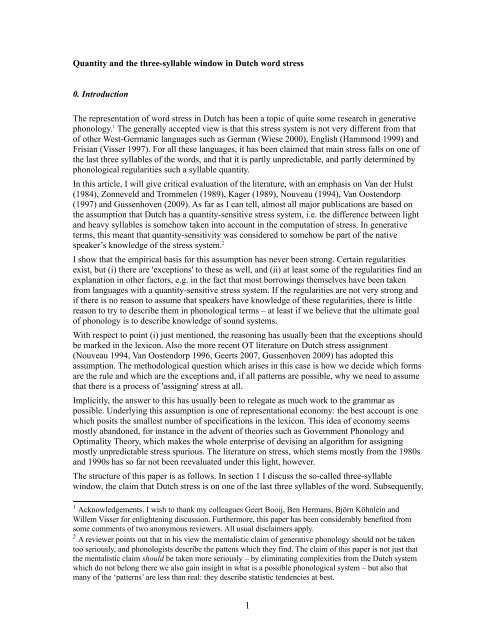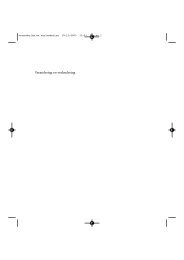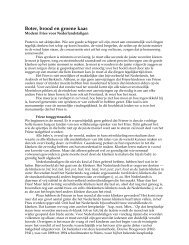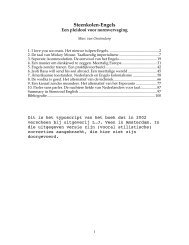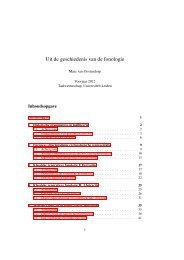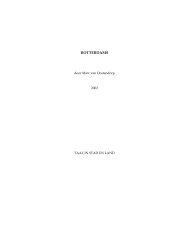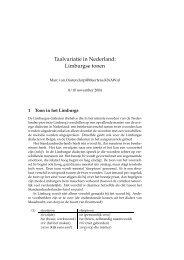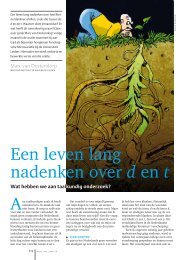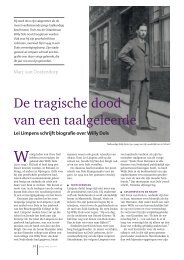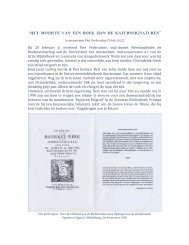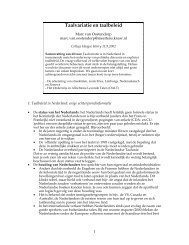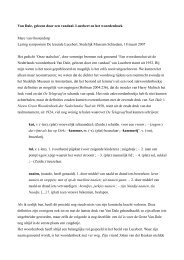Quantity and the three-syllable window in Dutch word stress 0 ...
Quantity and the three-syllable window in Dutch word stress 0 ...
Quantity and the three-syllable window in Dutch word stress 0 ...
Create successful ePaper yourself
Turn your PDF publications into a flip-book with our unique Google optimized e-Paper software.
<strong>Quantity</strong> <strong>and</strong> <strong>the</strong> <strong>three</strong>-<strong>syllable</strong> <strong>w<strong>in</strong>dow</strong> <strong>in</strong> <strong>Dutch</strong> <strong>word</strong> <strong>stress</strong><br />
0. Introduction<br />
The representation of <strong>word</strong> <strong>stress</strong> <strong>in</strong> <strong>Dutch</strong> has been a topic of quite some research <strong>in</strong> generative<br />
phonology. 1 The generally accepted view is that this <strong>stress</strong> system is not very different from that<br />
of o<strong>the</strong>r West-Germanic languages such as German (Wiese 2000), English (Hammond 1999) <strong>and</strong><br />
Frisian (Visser 1997). For all <strong>the</strong>se languages, it has been claimed that ma<strong>in</strong> <strong>stress</strong> falls on one of<br />
<strong>the</strong> last <strong>three</strong> <strong>syllable</strong>s of <strong>the</strong> <strong>word</strong>s, <strong>and</strong> that it is partly unpredictable, <strong>and</strong> partly determ<strong>in</strong>ed by<br />
phonological regularities such a <strong>syllable</strong> quantity.<br />
In this article, I will give critical evaluation of <strong>the</strong> literature, with an emphasis on Van der Hulst<br />
(1984), Zonneveld <strong>and</strong> Trommelen (1989), Kager (1989), Nouveau (1994), Van Oostendorp<br />
(1997) <strong>and</strong> Gussenhoven (2009). As far as I can tell, almost all major publications are based on<br />
<strong>the</strong> assumption that <strong>Dutch</strong> has a quantity-sensitive <strong>stress</strong> system, i.e. <strong>the</strong> difference between light<br />
<strong>and</strong> heavy <strong>syllable</strong>s is somehow taken <strong>in</strong>to account <strong>in</strong> <strong>the</strong> computation of <strong>stress</strong>. In generative<br />
terms, this meant that quantity-sensitivity was considered to somehow be part of <strong>the</strong> native<br />
speaker’s knowledge of <strong>the</strong> <strong>stress</strong> system. 2<br />
I show that <strong>the</strong> empirical basis for this assumption has never been strong. Certa<strong>in</strong> regularities<br />
exist, but (i) <strong>the</strong>re are 'exceptions' to <strong>the</strong>se as well, <strong>and</strong> (ii) at least some of <strong>the</strong> regularities f<strong>in</strong>d an<br />
explanation <strong>in</strong> o<strong>the</strong>r factors, e.g. <strong>in</strong> <strong>the</strong> fact that most borrow<strong>in</strong>gs <strong>the</strong>mselves have been taken<br />
from languages with a quantity-sensitive <strong>stress</strong> system. If <strong>the</strong> regularities are not very strong <strong>and</strong><br />
if <strong>the</strong>re is no reason to assume that speakers have knowledge of <strong>the</strong>se regularities, <strong>the</strong>re is little<br />
reason to try to describe <strong>the</strong>m <strong>in</strong> phonological terms – at least if we believe that <strong>the</strong> ultimate goal<br />
of phonology is to describe knowledge of sound systems.<br />
With respect to po<strong>in</strong>t (i) just mentioned, <strong>the</strong> reason<strong>in</strong>g has usually been that <strong>the</strong> exceptions should<br />
be marked <strong>in</strong> <strong>the</strong> lexicon. Also <strong>the</strong> more recent OT literature on <strong>Dutch</strong> <strong>stress</strong> assignment<br />
(Nouveau 1994, Van Oostendorp 1996, Geerts 2007, Gussenhoven 2009) has adopted this<br />
assumption. The methodological question which arises <strong>in</strong> this case is how we decide which forms<br />
are <strong>the</strong> rule <strong>and</strong> which are <strong>the</strong> exceptions <strong>and</strong>, if all patterns are possible, why we need to assume<br />
that <strong>the</strong>re is a process of 'assign<strong>in</strong>g' <strong>stress</strong> at all.<br />
Implicitly, <strong>the</strong> answer to this has usually been to relegate as much work to <strong>the</strong> grammar as<br />
possible. Underly<strong>in</strong>g this assumption is one of representational economy: <strong>the</strong> best account is one<br />
which posits <strong>the</strong> smallest number of specifications <strong>in</strong> <strong>the</strong> lexicon. This idea of economy seems<br />
mostly ab<strong>and</strong>oned, for <strong>in</strong>stance <strong>in</strong> <strong>the</strong> advent of <strong>the</strong>ories such as Government Phonology <strong>and</strong><br />
Optimality Theory, which makes <strong>the</strong> whole enterprise of devis<strong>in</strong>g an algorithm for assign<strong>in</strong>g<br />
mostly unpredictable <strong>stress</strong> spurious. The literature on <strong>stress</strong>, which stems mostly from <strong>the</strong> 1980s<br />
<strong>and</strong> 1990s has so far not been reevaluated under this light, however.<br />
The structure of this paper is as follows. In section 1 I discuss <strong>the</strong> so-called <strong>three</strong>-<strong>syllable</strong><br />
<strong>w<strong>in</strong>dow</strong>, <strong>the</strong> claim that <strong>Dutch</strong> <strong>stress</strong> is on one of <strong>the</strong> last <strong>three</strong> <strong>syllable</strong>s of <strong>the</strong> <strong>word</strong>. Subsequently,<br />
1 Acknowledgements. I wish to thank my colleagues Geert Booij, Ben Hermans, Björn Köhnle<strong>in</strong> <strong>and</strong><br />
Willem Visser for enlighten<strong>in</strong>g discussion. Fur<strong>the</strong>rmore, this paper has been considerably benefited from<br />
some comments of two anonymous reviewers. All usual disclaimers apply.<br />
2 A reviewer po<strong>in</strong>ts out that <strong>in</strong> his view <strong>the</strong> mentalistic claim of generative phonology should not be taken<br />
too seriously, <strong>and</strong> phonologists describe <strong>the</strong> pattens which <strong>the</strong>y f<strong>in</strong>d. The claim of this paper is not just that<br />
<strong>the</strong> mentalistic claim should be taken more seriously – by elim<strong>in</strong>at<strong>in</strong>g complexities from <strong>the</strong> <strong>Dutch</strong> system<br />
which do not belong <strong>the</strong>re we also ga<strong>in</strong> <strong>in</strong>sight <strong>in</strong> what is a possible phonological system – but also that<br />
many of <strong>the</strong> ‘patterns’ are less than real: <strong>the</strong>y describe statistic tendencies at best.<br />
1
we move to various types of weight which have been assumed to be relevant for <strong>stress</strong> assigment.<br />
Section 2 discusses <strong>the</strong> role of schwa <strong>and</strong> <strong>the</strong> dist<strong>in</strong>ction between light <strong>and</strong> heavy <strong>syllable</strong>s.<br />
Section 3 provides an overview of <strong>the</strong> relevant data on so-called superheavy <strong>syllable</strong>s. Section 4<br />
closes off with a discussion on <strong>the</strong> way <strong>in</strong> which we should evaluate <strong>the</strong> at first sight ra<strong>the</strong>r mixed<br />
results on quantity-sensitivity <strong>in</strong> <strong>Dutch</strong>.<br />
1. The <strong>three</strong>-<strong>syllable</strong> <strong>w<strong>in</strong>dow</strong><br />
The examples <strong>in</strong> (1) show that <strong>Dutch</strong> <strong>stress</strong> is at least partly lexical: <strong>the</strong>se pairs of <strong>word</strong>s differ<br />
from each o<strong>the</strong>r only <strong>in</strong> <strong>the</strong> location of <strong>stress</strong>, not <strong>in</strong> <strong>the</strong>ir segmental content or any o<strong>the</strong>r lexical<br />
property.<br />
(1) kanon 'gun' [ka'nɔn] canon ['kanɔn] 'norm'<br />
If <strong>Dutch</strong> <strong>stress</strong> were <strong>in</strong>disputably a purely unpredictable property of <strong>word</strong>s, <strong>the</strong>re obviously would<br />
not be a lot of discussion about it. Every <strong>word</strong> would have its specification of a <strong>stress</strong> position <strong>in</strong><br />
<strong>the</strong> lexicon, <strong>and</strong> <strong>the</strong> phonological grammar could stay silent. However, all scholars on <strong>Dutch</strong> of<br />
<strong>the</strong> past decades seem to agree that <strong>the</strong>re are several restrictions as to <strong>the</strong> position of primary<br />
<strong>stress</strong> (Booij 1995; Daelemans et al. 1994; Geerts 2008; Gussenhoven 1993, 2009; Kager 1989;<br />
Kager <strong>and</strong> Visch 1984; Kager, Visch <strong>and</strong> Zonneveld 1987; Kager <strong>and</strong> Zonneveld 1986; Kooij<br />
1978; Lahiri <strong>and</strong> Kooreman 1986; Langeweg 1988; Van Marle 1980; Neijt <strong>and</strong> Zonneveld 1982;<br />
Nouveau 1994; Van Oostendorp 1997; Rietveld et al. 2004; Trommelen 1991; Trommelen <strong>and</strong><br />
Zonneveld 1989, 1999; Visch <strong>and</strong> Kager 1984; Van Zonneveld 1984; Zonneveld 1993, 2003). The<br />
strongest consensus is probably on <strong>the</strong> claim that <strong>Dutch</strong> is subject to a <strong>three</strong>-<strong>syllable</strong> <strong>w<strong>in</strong>dow</strong>,<br />
familiar also from many o<strong>the</strong>r Indo-European languages. Stress outside of this <strong>w<strong>in</strong>dow</strong>, i.e. on <strong>the</strong><br />
preantepenultimate <strong>syllable</strong> of <strong>the</strong> <strong>word</strong>, is <strong>in</strong>deed rarely attested:<br />
(2) *['makaroni]<br />
In spite of this general consensus, it is hard to f<strong>in</strong>d clear evidence that this <strong>w<strong>in</strong>dow</strong> plays or has<br />
ever played an active role <strong>in</strong> <strong>the</strong> synchronic phonology of <strong>Dutch</strong>. As is well known,<br />
(West-)Germanic had systematic <strong>in</strong>itial <strong>stress</strong>, so we might expect long <strong>word</strong>s of this orig<strong>in</strong> to<br />
have shifted; but it is difficult to f<strong>in</strong>d monomorphemic West-Germanic forms which have <strong>the</strong><br />
required length. Trommelen (1989) argues that at least verbs tend to have at most one full vowel<br />
plus an optional schwa-headed <strong>syllable</strong>. Also longer nouns are borrowed from o<strong>the</strong>r languages.<br />
The relevant <strong>word</strong>s <strong>in</strong> contemparary <strong>Dutch</strong> thus have all been loan<strong>word</strong>s at some stage. The<br />
orig<strong>in</strong>al West Germanic pattern changed under <strong>the</strong> <strong>in</strong>fluence of Lat<strong>in</strong> or French or o<strong>the</strong>r Indo-<br />
European languages, <strong>in</strong> which <strong>the</strong> lexicon respects <strong>the</strong> <strong>three</strong>-<strong>syllable</strong> <strong>w<strong>in</strong>dow</strong> already. The<br />
macaroni example <strong>in</strong> (2), for <strong>in</strong>stance, is from Italian, <strong>in</strong> which all <strong>word</strong>s except for <strong>the</strong> third<br />
person plural of some verbs respect <strong>the</strong> <strong>w<strong>in</strong>dow</strong> (Krämer 2009): <strong>in</strong> order to get a <strong>w<strong>in</strong>dow</strong><br />
violation <strong>in</strong> <strong>the</strong> <strong>Dutch</strong> <strong>word</strong>, we would have to disrespect <strong>the</strong> Italian orig<strong>in</strong>al <strong>and</strong> <strong>the</strong>re seems little<br />
reason to do so.<br />
As a matter of fact, <strong>the</strong>re are two known classes of exceptions to <strong>the</strong> generalisation. The first<br />
consists of toponyms such as Scheven<strong>in</strong>gen, Amerongen <strong>and</strong> Wagen<strong>in</strong>gen; <strong>the</strong> second is a class of<br />
Lat<strong>in</strong> grammatical terms such as <strong>in</strong>f<strong>in</strong>itief, accusatief <strong>and</strong> nom<strong>in</strong>atief which all have <strong>in</strong>itial <strong>stress</strong>.<br />
Admittedly, <strong>the</strong>se two classes are small, but <strong>the</strong>re is no specific reason to see <strong>the</strong>se <strong>word</strong>s as<br />
2
somehow not belong<strong>in</strong>g to <strong>the</strong> <strong>Dutch</strong> lexicon or as be<strong>in</strong>g more foreign to it than many of <strong>the</strong><br />
trisyllabic <strong>word</strong>s. Actually, a CELEX search 3 shows a few more <strong>in</strong>dividual examples:<br />
(3) reutemeteut ‘caboodle’, ammelaken ‘table cloth’, t<strong>in</strong>geltangel ‘honkeytonk’, Erlenmeyer<br />
‘Erlenmeyer flask’<br />
The list is obviously not very long, two of <strong>the</strong> <strong>word</strong>s have some reduplicative quality to <strong>the</strong>m<br />
(however that may be <strong>in</strong>terpreted from a <strong>the</strong>oretical po<strong>in</strong>t of view), ammelaken is a <strong>word</strong> which<br />
was unknown to <strong>the</strong> author of this article <strong>and</strong> which may have a compound-like quality to those<br />
who do know it, <strong>and</strong> erlenmeyer is eponymous - while names have been argued to have a separate<br />
<strong>stress</strong> pattern.<br />
The crucial argument that <strong>Dutch</strong> respects <strong>the</strong> <strong>three</strong>-<strong>syllable</strong> <strong>w<strong>in</strong>dow</strong> thus is that exceptions may<br />
be ignored by phonological <strong>the</strong>ory as long as <strong>the</strong>y are few <strong>in</strong> number. It is not so evident,<br />
however, what this argument is based on. In order to make it precise, let us assume a concrete<br />
analysis of <strong>Dutch</strong> <strong>stress</strong>, for <strong>in</strong>stance with<strong>in</strong> Optimality Theory. The <strong>three</strong>-<strong>syllable</strong> <strong>w<strong>in</strong>dow</strong> could<br />
be made to follow from <strong>the</strong> (plausible) assumptions that <strong>Dutch</strong> has trochaic feet, 4 that <strong>stress</strong> is<br />
typically on <strong>the</strong> rightmost of <strong>the</strong>se feet, <strong>and</strong> f<strong>in</strong>ally that <strong>the</strong> last <strong>syllable</strong> can be 'extrametrical' (not<br />
parsed <strong>in</strong>to a foot), or 'catalectic' (i.e. empty, so that a <strong>word</strong> end<strong>in</strong>g <strong>in</strong> a phonological bisyllabic<br />
trochee ends <strong>in</strong> a <strong>stress</strong>ed <strong>syllable</strong> phonetically). This complex will give us <strong>the</strong> impossibility of<br />
preantepenultimate <strong>stress</strong> allow<strong>in</strong>g all o<strong>the</strong>r possibilities: 5<br />
(4)<br />
makaroni STRESS RIGHTMOST FOOT PARSE-SYLLABLE<br />
(maka)('roni)<br />
('maka)roni W *<br />
('maka)(roni) W *<br />
But we somehow have to <strong>in</strong>clude <strong>word</strong>s like <strong>in</strong>f<strong>in</strong>itief <strong>in</strong>to <strong>the</strong> picture. One way to do this would<br />
be to mark <strong>stress</strong> on this <strong>word</strong> <strong>and</strong> assume that faithfulness to this mark<strong>in</strong>g is dom<strong>in</strong>ant: 6<br />
(5)<br />
'<strong>in</strong>f<strong>in</strong>itief FAITHFULNESS STRESS RIGHTMOST FOOT PARSE-SYLLABLE<br />
a ('<strong>in</strong>fi)nitief *<br />
3 CELEX (http://celex.mpi.nl/) is a huge database with <strong>Dutch</strong> <strong>word</strong>s, based on a number of balanced<br />
corpora of written <strong>Dutch</strong>. For this article, I have used <strong>the</strong> section ‘<strong>Dutch</strong> lemma’s’ <strong>and</strong> selected only <strong>the</strong><br />
monomorphemic <strong>word</strong>s.. Morphology <strong>in</strong>teracts with <strong>stress</strong> <strong>in</strong> a very <strong>in</strong>terest<strong>in</strong>g way <strong>in</strong> <strong>Dutch</strong>, but that is<br />
not <strong>the</strong> topic of this paper.<br />
4 One conv<strong>in</strong>c<strong>in</strong>g argument for trochaic foot which is not directly based on <strong>stress</strong>, but ra<strong>the</strong>r on an<br />
<strong>in</strong>tonational phenomenon called <strong>the</strong> 'chanted call', can be found <strong>in</strong> Gussenhoven (1993).<br />
5 We will just assume trochaic feet, so that <strong>the</strong> constra<strong>in</strong>t disallow<strong>in</strong>g iambs is not needed <strong>in</strong> <strong>the</strong> tableaux.<br />
6 In this example, <strong>the</strong> form with only one foot w<strong>in</strong>s, because of <strong>the</strong> relative rank<strong>in</strong>g of Stress-rightmost <strong>and</strong><br />
Parse-<strong>syllable</strong>. We could also reverse <strong>the</strong> rank<strong>in</strong>g, <strong>in</strong> which case (b) would w<strong>in</strong>, which is phonetically<br />
equivalent. S<strong>in</strong>ce this is a sample analysis, <strong>the</strong>re is no reason to go <strong>in</strong>to this discussion here.<br />
3
('<strong>in</strong>fi)(nitief) W * L<br />
c (<strong>in</strong>fi)('nitief) W * L<br />
Obviously, however, as soon as faithfulness outranks everyth<strong>in</strong>g else, we are no longer really<br />
say<strong>in</strong>g that <strong>the</strong>re is a <strong>three</strong>-<strong>syllable</strong> <strong>w<strong>in</strong>dow</strong> <strong>in</strong> <strong>the</strong> language. The constra<strong>in</strong>ts are <strong>the</strong>re, but <strong>the</strong>y<br />
are low-ranked, as <strong>in</strong> any language which does not satisfy <strong>the</strong>m at all. One way out would be to<br />
assume that this rank<strong>in</strong>g is specific for <strong>word</strong>s such as <strong>in</strong>f<strong>in</strong>itief, etc. (for <strong>in</strong>stance because <strong>the</strong>re is<br />
a cophonology apply<strong>in</strong>g only to grammatical terms <strong>and</strong> a few o<strong>the</strong>r <strong>word</strong>s). The issue is, however,<br />
that it is not clear what would be ga<strong>in</strong>ed by this latter move as compared to <strong>the</strong> assumption that<br />
faithfulness is dom<strong>in</strong>ant for all <strong>word</strong>s, <strong>and</strong> it just happens that most <strong>word</strong>s have <strong>stress</strong> somewhere<br />
on one of <strong>the</strong> last <strong>three</strong> <strong>syllable</strong>s. In o<strong>the</strong>r <strong>word</strong>s, although it is clear that <strong>the</strong>re is a statistical<br />
tendency of avoid<strong>in</strong>g preantepenultimate <strong>stress</strong>, it is not clear why this should be turned <strong>in</strong>to an<br />
absolute truth, also because <strong>the</strong>re is an alternative explanation which may be even more suitable<br />
for <strong>the</strong> pattern at h<strong>and</strong>: <strong>the</strong> <strong>word</strong>s have kept <strong>the</strong>ir orig<strong>in</strong>al <strong>stress</strong> pattern from <strong>the</strong> source language.<br />
Crucial evidence would come from <strong>the</strong> way <strong>in</strong> which loan<strong>word</strong>s from languages without a <strong>three</strong><strong>syllable</strong><br />
<strong>w<strong>in</strong>dow</strong> are treated, but I have not been able to f<strong>in</strong>d an uncontroversial <strong>in</strong>stance of this <strong>in</strong><br />
<strong>the</strong> literature. Fur<strong>the</strong>rmore, show<strong>in</strong>g that <strong>word</strong>s from those languages get regularized to e.g.<br />
penultimate <strong>stress</strong> would not be sufficient. It could be that penultimate <strong>stress</strong> simply is <strong>the</strong> default<br />
(that def<strong>in</strong>itely seems <strong>the</strong> most likely position for such a status), so that we need to show that<br />
loan<strong>word</strong>s never get regularized to antepenultimate or ultimate <strong>stress</strong>. As far as I am aware,<br />
evidence about this is lack<strong>in</strong>g.<br />
Ano<strong>the</strong>r type of evidence would be alternations such as we f<strong>in</strong>d for <strong>in</strong>stance <strong>in</strong> Greek. In this<br />
language, if we comb<strong>in</strong>e a stem that has antepenultimate <strong>stress</strong> with a clitic or a suffix, <strong>the</strong> <strong>stress</strong><br />
shifts (<strong>in</strong> <strong>the</strong> case of clitics, <strong>the</strong> <strong>stress</strong> on <strong>the</strong> noun is kept as some k<strong>in</strong>d of secondary <strong>stress</strong>, see<br />
(6a-b); this is not <strong>the</strong> case for <strong>the</strong> <strong>in</strong>flectional suffix <strong>in</strong> (6d)):<br />
(6) a. góndola (id) > gondolá-mu ‘my gondola’<br />
b. o jítonas ‘<strong>the</strong> neighbour’ > o jítonás mas ‘our neighbour’<br />
c. cf. stafída > stafída-mu (without <strong>stress</strong> shift)<br />
d. to máthima ‘<strong>the</strong> lesson’ > to mathímatos ‘of <strong>the</strong> lesson’<br />
<strong>Dutch</strong> lacks any alternations of this type. This should not be counted as evidence aga<strong>in</strong>st a <strong>three</strong><strong>syllable</strong><br />
<strong>w<strong>in</strong>dow</strong>, s<strong>in</strong>ce <strong>the</strong>re simply are also no clitics or suffixes forc<strong>in</strong>g violation of this putative<br />
constra<strong>in</strong>t. The evidence is thus completely neutral on this po<strong>in</strong>t. But <strong>the</strong> lack of alternations of<br />
this type would make it def<strong>in</strong>itely hard for a language-learner to detect <strong>the</strong> activity of <strong>the</strong> putative<br />
constra<strong>in</strong>t.<br />
The little evidence we do have <strong>in</strong> <strong>the</strong> literature concerns a study by Nouveau (1994) on <strong>the</strong><br />
acquisition of <strong>stress</strong>, where <strong>the</strong> author used nonsense <strong>word</strong>s to test children's knowledge. Two of<br />
<strong>the</strong>se nonsense <strong>word</strong>s had <strong>the</strong> required length (both of <strong>the</strong>m were 4 <strong>syllable</strong>s long). Two parts of<br />
Nouveau's study are relevant for our present purposes. In <strong>the</strong> first place, Nouveau did a 'pretest'<br />
with 20 adult <strong>in</strong>formants, who were asked to read <strong>the</strong> <strong>word</strong>s aloud. The <strong>stress</strong> was <strong>the</strong>n<br />
transcribed. It turned out that no <strong>in</strong>formant was ever tempted to put <strong>stress</strong> on <strong>the</strong> first <strong>syllable</strong> of<br />
such long <strong>word</strong>s (P.ant=preantepenultimate, Ant=antepenultimate, Pen=penultimate, F<strong>in</strong>=f<strong>in</strong>al):<br />
(7) P.ant Ant Pen F<strong>in</strong><br />
4
karabilo 0 1 18 1<br />
monitaron 0 6 8 6<br />
These data are suggestive, but one would of course need more of <strong>the</strong>m to start mak<strong>in</strong>g statistical<br />
sense. Fur<strong>the</strong>rmore, <strong>the</strong> fact that <strong>in</strong> a group of 20 <strong>in</strong>dividuals nobody puts <strong>the</strong> <strong>stress</strong> on <strong>the</strong> first<br />
four <strong>syllable</strong>s, does not necessarily mean that it is disallowed on that <strong>syllable</strong>; notice that all o<strong>the</strong>r<br />
<strong>word</strong>s <strong>in</strong> <strong>the</strong> experiment were shorter, so that <strong>the</strong> bias could even be due to some repetition effect<br />
<strong>in</strong>herent <strong>in</strong> <strong>the</strong> experimental design (people got used to putt<strong>in</strong>g <strong>stress</strong> on one of <strong>the</strong> last <strong>three</strong><br />
<strong>syllable</strong>s, because <strong>the</strong>se were usually <strong>the</strong> only <strong>syllable</strong>s available).<br />
The second piece of <strong>in</strong>formation which might be relevant, although even more difficult to<br />
<strong>in</strong>terpret, is <strong>the</strong> result of <strong>the</strong> experiment with (3- <strong>and</strong> 4-year-old) children. They were presented<br />
with a doll which was given a name by <strong>the</strong> researcher. This name was one of <strong>the</strong> nonsense <strong>word</strong>s<br />
comb<strong>in</strong>ed with one of <strong>the</strong> logically possible <strong>stress</strong>es. After a while, <strong>the</strong> children were asked to<br />
repeat <strong>the</strong>se names, <strong>and</strong> it was recorded whe<strong>the</strong>r <strong>the</strong>y did so correctly or not.<br />
(8) Three-year-olds<br />
P.ant Ant Pen F<strong>in</strong><br />
karabilo 65% 30% 20% 65%<br />
monitaron 50% 35% 45% 55%<br />
Four-year-olds<br />
P.ant Ant Pen F<strong>in</strong><br />
karabilo 70% 30% 5% 50%<br />
monitaron 60% 35% 65% 55%<br />
These tables should be read <strong>in</strong> <strong>the</strong> follow<strong>in</strong>g way. When children were asked to repeat kárabilo,<br />
65% of <strong>the</strong> <strong>three</strong>-your olds did so <strong>in</strong>correctly; when <strong>the</strong>y had to repeat karábilo, 30% made a<br />
mistake, etc. (Only mistakes were counted that <strong>in</strong>fluenced <strong>the</strong> <strong>stress</strong> pattern, such as replac<strong>in</strong>g <strong>the</strong><br />
accent, or delet<strong>in</strong>g certa<strong>in</strong> <strong>syllable</strong>s, etc.)<br />
We have performed a similarly small onl<strong>in</strong>e study <strong>in</strong> which <strong>in</strong>formants (26 participants, all from<br />
<strong>the</strong> Ne<strong>the</strong>rl<strong>and</strong>s, all with <strong>Dutch</strong> as <strong>the</strong>ir native language) were asked about <strong>the</strong> <strong>stress</strong> patterns <strong>in</strong><br />
(<strong>Dutch</strong> versions of) biblical names. Most of <strong>the</strong>se names are unknown even to many observant<br />
Jews <strong>and</strong> Christians, for <strong>in</strong>stance <strong>the</strong>y occur only once <strong>in</strong> <strong>the</strong> bible. Informants got a list of<br />
approximately 50 names, <strong>and</strong> had to <strong>in</strong>dicate where (ma<strong>in</strong>) <strong>stress</strong> should be accord<strong>in</strong>g to <strong>the</strong>ir<br />
<strong>in</strong>tuition. The study presented here is a pilot study, but it shows data very similar to those of<br />
Nouveau:<br />
(9) P.P.ant P.ant Ant Pen F<strong>in</strong><br />
timnatcheres - 42 0 42 3<br />
pars<strong>and</strong>ata - 23 15 50 0<br />
leviatan - 19 7 69 3<br />
hermogenes - 7 46 38 0<br />
5
enh<strong>in</strong>nomdal - 3 69 11 3<br />
akrabattene 19 3 23 42 0<br />
apollonia 7 11 76 0 7<br />
As a matter of fact, it turns out that <strong>in</strong> <strong>the</strong>se <strong>word</strong>s <strong>the</strong> preantepenultimate <strong>syllable</strong> was<br />
systematically preferred as a <strong>stress</strong> location over <strong>the</strong> f<strong>in</strong>al <strong>syllable</strong>, although this difference is<br />
ra<strong>the</strong>r small <strong>in</strong> each case. It is possible that <strong>in</strong> some of <strong>the</strong>se cases <strong>the</strong> names were analysed as<br />
be<strong>in</strong>g compounds, which may expla<strong>in</strong> <strong>the</strong>n some of <strong>the</strong> <strong>stress</strong>es outside of <strong>the</strong> <strong>three</strong>-<strong>syllable</strong><br />
<strong>w<strong>in</strong>dow</strong>, but that would merely show that <strong>Dutch</strong> speakers consider long <strong>word</strong>s impossible.<br />
Obviously, <strong>the</strong>se data are less supportive of <strong>the</strong> idea that <strong>Dutch</strong> has an active constra<strong>in</strong>t aga<strong>in</strong>st<br />
preantepenultimate <strong>stress</strong>, although it does show that <strong>the</strong>re may be a default, or at least a<br />
preference for penultimate <strong>stress</strong>. Although children made a lot of 'errors' when hav<strong>in</strong>g to repeat<br />
<strong>the</strong> 'impossible' pattern, <strong>the</strong>y also did so for o<strong>the</strong>r positions, <strong>and</strong> <strong>in</strong> some cases even more so (e.g.<br />
<strong>the</strong> penultimate position on monitaron triggered more errors <strong>in</strong> four-year-olds than <strong>the</strong><br />
preantepenultimate). Of course, also this can hardly be counted as an argument aga<strong>in</strong>st such a<br />
constra<strong>in</strong>t ei<strong>the</strong>r; <strong>the</strong> evidence is aga<strong>in</strong> simply neutral. However this may be, even though a large<br />
majority of <strong>word</strong>s satisfy <strong>the</strong> constra<strong>in</strong>t, clear evidence for <strong>the</strong> <strong>three</strong>-<strong>syllable</strong> <strong>w<strong>in</strong>dow</strong> as a<br />
synchronic constra<strong>in</strong>t of <strong>Dutch</strong> phonology seems lack<strong>in</strong>g.<br />
2. <strong>Quantity</strong> sensitivity<br />
2.1 Schwa<br />
Ano<strong>the</strong>r generalisation for which <strong>the</strong>re is strong scholarly support <strong>in</strong> <strong>the</strong> literature is weight<br />
sensitivity. Generally, four levels of weight are dist<strong>in</strong>guished: (a) schwa <strong>syllable</strong>s, (b) light<br />
<strong>syllable</strong>s, (c) heavy <strong>syllable</strong>s, (d) superheavy <strong>syllable</strong>s, where <strong>the</strong> first are supposed to avoid<br />
<strong>stress</strong> altoge<strong>the</strong>r, whereas <strong>the</strong> last should be always <strong>stress</strong>ed (Daelemans et al. 1994).<br />
The evidence that we should dist<strong>in</strong>guish schwa <strong>syllable</strong>s from <strong>the</strong> rest is strong. There simply are<br />
no lexical <strong>word</strong>s with a schwa <strong>syllable</strong> carry<strong>in</strong>g lexical <strong>stress</strong>, although schwa can carry<br />
contrastive <strong>stress</strong> <strong>in</strong> very specific contexts:<br />
(10) Ik zeg geen cod'a maar cod'e<br />
I don't say [kod'a] but [kod'ə]<br />
S<strong>in</strong>ce such contrastive <strong>stress</strong> can basically overrule all lexical specifications, we consider this to<br />
be irrelevant for <strong>the</strong> issue at h<strong>and</strong>, except that it shows that <strong>stress</strong> on schwa is not a phonetic<br />
impossibility <strong>and</strong> <strong>the</strong>refore that <strong>the</strong> <strong>stress</strong> avoidance of schwa outside contrastive positions is a<br />
phonological fact.<br />
As a matter of fact, Van der Hulst (1984:233) notes as a tendency that <strong>stress</strong> immediately<br />
precedes schwa, i.e. <strong>in</strong> <strong>word</strong>s end<strong>in</strong>g <strong>in</strong> a schwa-headed <strong>syllable</strong>, <strong>stress</strong> is on <strong>the</strong> pref<strong>in</strong>al <strong>syllable</strong>.<br />
Van der Hulst mentions <strong>the</strong> examples <strong>in</strong> (a) as an exhaustive list of 'exceptions' to this<br />
generalisation <strong>and</strong> a CELEX search yields <strong>the</strong> additional examples <strong>in</strong> (b):<br />
(11) a. Mánchester (place name), ármoede 'poverty', Níjmegen (place name), wéduwe (widow),<br />
óórkonde (deed), Bétuwe (place name), Véluwe (place name)<br />
6
. máluwe (malva), clítoris (id), s´yfilis (syphilis), cánnabis (id), sáuriër (saurus), térriër<br />
(dog)<br />
However, all of <strong>the</strong>se are somewhat problematic. I am not sure that Manchester counts as a <strong>Dutch</strong><br />
<strong>word</strong>; armoede <strong>and</strong> oorkonde (<strong>and</strong> possibly also Nijmegen) could count as prosodic compounds<br />
(see section 4), <strong>the</strong> <strong>word</strong>s which are spelled <strong>in</strong> have a front vowel at least for me (<strong>and</strong><br />
fur<strong>the</strong>rmore clitoris seems to have penultimate <strong>stress</strong> for many speakers); <strong>and</strong> <strong>the</strong> o<strong>the</strong>r forms<br />
(weduwe, betuwe, veluwe, maluwe, sauriër, terriër) all end <strong>in</strong> a sequence high vowel-glide-schwa,<br />
on which see e.g. Trommelen 1983, Zonneveld 1993, Van Oostendorp (2000).<br />
The l<strong>in</strong>e of reason<strong>in</strong>g we followed <strong>in</strong> section 1 to disqualify <strong>the</strong> <strong>three</strong>-<strong>syllable</strong> <strong>w<strong>in</strong>dow</strong> as a<br />
generalisation of <strong>Dutch</strong> synchronic phonology doesn't apply at least for <strong>the</strong> <strong>stress</strong>lessness of<br />
schwa, s<strong>in</strong>ce <strong>the</strong>re are no exceptions <strong>and</strong> fur<strong>the</strong>rmore, <strong>the</strong>re is an <strong>in</strong>dependent <strong>in</strong>dication that <strong>the</strong><br />
relation between be<strong>in</strong>g un<strong>stress</strong>ed <strong>and</strong> be<strong>in</strong>g schwa is strong <strong>in</strong> <strong>Dutch</strong>. The language has vocalic<br />
reduction. Depend<strong>in</strong>g on a number of factors, <strong>in</strong>clud<strong>in</strong>g <strong>the</strong> quality of <strong>the</strong> orig<strong>in</strong>al vowel, style<br />
level of speech <strong>and</strong> <strong>the</strong> <strong>syllable</strong> structure, un<strong>stress</strong>ed vowels get reduced to schwa. In particular<br />
[e] <strong>in</strong> open <strong>syllable</strong>s is very sensitive to reduction, so that [e] <strong>in</strong> <strong>stress</strong>ed position, <strong>and</strong> [ə] <strong>in</strong><br />
un<strong>stress</strong>ed position are almost <strong>in</strong> complementary distribution ('t Hart 1967; Booij 1976, 1982;<br />
Kager 1989; Koopmans-Van Be<strong>in</strong>um 1980; Van Oostendorp 2000; Zonneveld 1993). S<strong>in</strong>ce <strong>the</strong>re<br />
are alternations <strong>and</strong> <strong>the</strong>se are triggered by <strong>stress</strong>, <strong>the</strong> connection between metrical weakness <strong>and</strong><br />
be<strong>in</strong>g schwa seems to be a real fact of <strong>Dutch</strong> synchronic phonology.<br />
2.2. Light <strong>and</strong> heavy <strong>syllable</strong>s<br />
The dist<strong>in</strong>ction between light <strong>and</strong> heavy <strong>syllable</strong>s is a little bit more controversial. We could raise<br />
two issues. 7 First, <strong>the</strong> def<strong>in</strong>ition of <strong>the</strong> dist<strong>in</strong>ction is somewhat unusual. Secondly, we could<br />
wonder whe<strong>the</strong>r we need to refer to <strong>the</strong> dist<strong>in</strong>ction at all.<br />
The def<strong>in</strong>ition issue is <strong>the</strong> follow<strong>in</strong>g one. Disregard<strong>in</strong>g schwa, <strong>Dutch</strong> has two sets of vowels:<br />
tense vowels, which only occur <strong>in</strong> open <strong>syllable</strong>s, <strong>and</strong> lax vowels, which only occur <strong>in</strong> closed<br />
<strong>syllable</strong>s. 8 Accord<strong>in</strong>g to some authors (for <strong>in</strong>stance, Zonneveld 1993, Kooij <strong>and</strong> Van Oostendorp<br />
2004), this phonotactic pattern can be described by assum<strong>in</strong>g that <strong>the</strong> tense vowels are<br />
phonologically long – many of <strong>the</strong>m are so phonetically as well, although <strong>the</strong> high tense vowels<br />
are not – <strong>and</strong> fur<strong>the</strong>rmore that every <strong>Dutch</strong> <strong>syllable</strong> is m<strong>in</strong>imally bimoraic. This implies that <strong>the</strong>re<br />
are basically two types of <strong>syllable</strong>s <strong>in</strong> <strong>Dutch</strong>: C(C)VV <strong>and</strong> C(C)VC. The curious th<strong>in</strong>g is,<br />
however, that <strong>the</strong> available evidence seems to po<strong>in</strong>t <strong>in</strong> <strong>the</strong> direction of CVV be<strong>in</strong>g light <strong>and</strong> CVC<br />
be<strong>in</strong>g heavy. This is quite unexpected: exist<strong>in</strong>g typologies of <strong>syllable</strong> weight would predict that it<br />
is <strong>the</strong> opposite. 9<br />
The evidence <strong>in</strong> favour of a heavy-light dist<strong>in</strong>ction <strong>in</strong> <strong>Dutch</strong> is a little bit subtle, to say <strong>the</strong> least. I<br />
will discuss two types of evidence. In section 2.3. I will turn to putative evidence that <strong>the</strong><br />
7 Booij (1995:101, fn. 8) is one of <strong>the</strong> few recent sources who cast doubt on <strong>the</strong> weight-sensitivity of <strong>Dutch</strong><br />
<strong>stress</strong>.<br />
8 The generalisation as described here is true <strong>word</strong>-<strong>in</strong>ternally. At <strong>the</strong> edges of <strong>word</strong>, we can have at most<br />
one extra non-coronal consonant, so that f<strong>in</strong>al tense vowels can be <strong>in</strong> a <strong>syllable</strong> closed by one, <strong>and</strong> lax<br />
vowels <strong>in</strong> a <strong>syllable</strong> closed by two consonants. Fur<strong>the</strong>rmore, one or more voiceless coronal obstruents (s or<br />
t) can follow this complex.<br />
9 This problem can be solved under an alternative view of <strong>syllable</strong> structure <strong>and</strong> its relation to segmental<br />
phonology which has it that phonologically tense <strong>and</strong> lax vowels are all short, <strong>the</strong> only relevant dist<strong>in</strong>ction<br />
be<strong>in</strong>g one which is described by a feature such as [tense], [lax] or [ATR], so that <strong>Dutch</strong> has two types of<br />
<strong>syllable</strong>s, of which CV would be light <strong>and</strong> CVC would be heavy (Van Oostendorp 2000).<br />
7
dist<strong>in</strong>ction plays a role <strong>in</strong> <strong>the</strong> calculation of secondary <strong>stress</strong>. Here, I concentrate on <strong>the</strong> special<br />
role of <strong>the</strong> penultimate <strong>syllable</strong>. Many authors have po<strong>in</strong>ted to <strong>the</strong> generalisation <strong>in</strong> (12):<br />
(12) When <strong>the</strong> penultimate <strong>syllable</strong> is heavy, <strong>stress</strong> cannot be on <strong>the</strong> antepenultimate.<br />
(13) A'genda, frican'deau, *'agenda, *'fric<strong>and</strong>eau<br />
A careful study based on a <strong>word</strong> list is provided by Van der Hulst (1984). Assum<strong>in</strong>g that tense<br />
vowels are long, Van der Hulst reports zero <strong>word</strong>s with <strong>in</strong>itial <strong>stress</strong> for trisyllabic <strong>word</strong>s of <strong>the</strong><br />
shapes <strong>in</strong> (14a); if <strong>the</strong> penultimate <strong>syllable</strong> is open, on <strong>the</strong> o<strong>the</strong>r h<strong>and</strong>, we do f<strong>in</strong>d cases with<br />
<strong>in</strong>itial <strong>stress</strong>. After each pattern we give two numbers; <strong>the</strong> first is <strong>the</strong> number of <strong>word</strong>s <strong>in</strong> Van der<br />
Hulst's data which had <strong>in</strong>itial <strong>stress</strong>, <strong>the</strong> second <strong>the</strong> total number of <strong>word</strong>s with <strong>the</strong> relevant<br />
<strong>syllable</strong> profile (Van der Hulst 1984:223):<br />
(14) a. No <strong>in</strong>itial <strong>stress</strong> when penultimate <strong>syllable</strong> is closed: VC-VC-VC (0/15), VC-VC-VV<br />
(0/28), VV-VC-VC (0/19), VV-VC-VV (0/54)<br />
b. Initial <strong>stress</strong> when penultimate <strong>syllable</strong> is open: VC-VV-VV (21/72), VV-VV-VV<br />
(59/182), VV-VV-VC (60/115), VC-VV-VC (40/66)<br />
However, a CELEX search shows counterexamples for each of <strong>the</strong> classes <strong>in</strong> (14a) that are<br />
supposed to be impossible:<br />
(15) a. ’VC. VC. VC mangistan, badm<strong>in</strong>ton<br />
b. ’VC. VC. VV chimpanzee<br />
c. ‘VV.VC.VV shoarma<br />
d. (VC).’VV.VC.VC sanniyas<strong>in</strong><br />
I have to add to this that many native speakers <strong>in</strong> an <strong>in</strong>formal survey put <strong>stress</strong> on <strong>the</strong> heavy<br />
<strong>syllable</strong> <strong>in</strong> both (c) <strong>and</strong> (d), so that we could possibly say that <strong>word</strong>s with a heavy penultimate<br />
<strong>and</strong> a light antepenultimate <strong>syllable</strong> never have <strong>stress</strong> on <strong>the</strong> latter; but I know of no <strong>the</strong>ory which<br />
could make this particular prediction. (Also, it is clear that <strong>the</strong> penultimate <strong>syllable</strong> is a default<br />
location for <strong>stress</strong>, also if it is light.)<br />
The follow<strong>in</strong>g graph shows <strong>the</strong> differences between <strong>stress</strong> patterns <strong>in</strong> <strong>word</strong>s with an open (blue<br />
l<strong>in</strong>e) <strong>and</strong> closed (red, dashed l<strong>in</strong>e) penultimate <strong>syllable</strong>. It can be clearly seen that <strong>in</strong> both cases,<br />
<strong>the</strong>re is a strong tendency to put <strong>stress</strong> on that penultimate <strong>syllable</strong>. For heavy <strong>syllable</strong>s we f<strong>in</strong>d<br />
less <strong>stress</strong> on o<strong>the</strong>r positions, but this is true both for <strong>the</strong> antepenultimate <strong>and</strong> <strong>the</strong> ultimate<br />
<strong>syllable</strong>:<br />
8
The difference between open <strong>and</strong> closed penultimate <strong>syllable</strong>s is of course still significant, but it<br />
seems to me that nei<strong>the</strong>r chimpanzee nor badm<strong>in</strong>ton sounds very eccentric to <strong>the</strong> average <strong>Dutch</strong><br />
ear.<br />
Accord<strong>in</strong>g to most authors (Van der Hulst 1984, Trommelen <strong>and</strong> Zonneveld 1989, Kager 1989,<br />
Nouveau 1994), weight is visible on <strong>the</strong> f<strong>in</strong>al <strong>syllable</strong> as well, albeit <strong>in</strong> a slightly more<br />
complicated way: <strong>in</strong> <strong>word</strong>s of <strong>the</strong> shape VX-VV-VC <strong>the</strong>re is a preference for <strong>in</strong>itial <strong>stress</strong> over<br />
penultimate <strong>stress</strong>, which may be caused by <strong>the</strong> fact that <strong>the</strong> latter two <strong>syllable</strong>s do not form a<br />
good trochee toge<strong>the</strong>r. This is confirmed by <strong>the</strong> follow<strong>in</strong>g graph, based aga<strong>in</strong> on a CELEX<br />
search:<br />
9
However, this graph also shows that <strong>the</strong> o<strong>the</strong>r two <strong>stress</strong> patterns are also possible for <strong>word</strong>s of<br />
this type (as a matter of fact, <strong>the</strong>re are even more cases of <strong>stress</strong> on <strong>the</strong> f<strong>in</strong>al <strong>syllable</strong>), <strong>and</strong> it is not<br />
clear what to make of that.<br />
Fur<strong>the</strong>rmore, it is not clear to what extent a language learner needs to know <strong>the</strong> generalisations <strong>in</strong><br />
(10) <strong>in</strong> any relevant sense of <strong>the</strong> <strong>word</strong> 'to know', s<strong>in</strong>ce this type of weight sensitivity is present<br />
also <strong>in</strong> <strong>the</strong> most common source languages for loan<strong>word</strong>s.<br />
On <strong>the</strong> o<strong>the</strong>r h<strong>and</strong>, <strong>the</strong>re is some evidence that <strong>stress</strong> patterns violat<strong>in</strong>g (12) are treated as marked<br />
by <strong>the</strong> language users: <strong>the</strong>y tend to undergo regularization. This evidence aga<strong>in</strong> comes from<br />
experiments with nonsense <strong>word</strong>s. Nouveau's (1994) test with adults conta<strong>in</strong>ed four <strong>three</strong>-syllabic<br />
<strong>word</strong>s with a heavy penultimate <strong>syllable</strong>. As before, we <strong>in</strong>dicate <strong>the</strong> number of <strong>in</strong>formants who<br />
assigned <strong>in</strong>itial <strong>stress</strong>, <strong>and</strong> <strong>the</strong> total number of renditions of <strong>the</strong> <strong>word</strong>:<br />
(16) ka-nak-ta (0/20)<br />
ma-rot-ko (0/20)<br />
ta-lak-tan (2/20)<br />
ba-ral-ton (6/20)<br />
At least <strong>in</strong> <strong>the</strong> f<strong>in</strong>al case <strong>the</strong> number of responses which gave <strong>in</strong>itial <strong>stress</strong> were 1:3, i.e. at chance<br />
level (s<strong>in</strong>ce <strong>the</strong>re were <strong>three</strong> <strong>syllable</strong>s). Fur<strong>the</strong>rmore, <strong>in</strong> <strong>the</strong> first two examples (<strong>in</strong> which <strong>the</strong> f<strong>in</strong>al<br />
<strong>syllable</strong> is open), <strong>the</strong>re were no <strong>stress</strong>es on <strong>the</strong> <strong>in</strong>itial <strong>syllable</strong> might be related to <strong>the</strong> fact that<br />
nobody <strong>stress</strong>ed <strong>the</strong> f<strong>in</strong>al <strong>syllable</strong> <strong>in</strong> <strong>the</strong>se cases ei<strong>the</strong>r: everybody said kanákta <strong>and</strong> marótko. A<br />
fur<strong>the</strong>r po<strong>in</strong>t to note is that <strong>the</strong> example which does show f<strong>in</strong>al <strong>stress</strong> is <strong>the</strong> only one <strong>in</strong> which <strong>the</strong><br />
penultimate is closed by a sonorant, which should count as <strong>the</strong> ‘heaviest’ of consonants.<br />
Zonneveld (2003) did a similar experiment with a group of 44 students, <strong>and</strong> found <strong>the</strong> patterns<br />
such as <strong>the</strong> follow<strong>in</strong>g:<br />
(17) a. to-gar-ma 4 39 1<br />
te-man-do 3 40 1<br />
b. po-tran-dat 7 22 15<br />
tri-men-tok 13 20 11<br />
Zonneveld (2003) concludes from this that antepenultimate <strong>stress</strong> is impossible on <strong>word</strong>s end<strong>in</strong>g<br />
<strong>in</strong> a VC-VV pattern. This is <strong>in</strong>deed someth<strong>in</strong>g that seems to arise from <strong>the</strong>se experimental data,<br />
but as far as I can see it does not take <strong>in</strong>to account <strong>the</strong> real <strong>word</strong>s chimpanzee <strong>and</strong> (possibly)<br />
shoarma.<br />
It thus seems fair to say that <strong>the</strong>re are several statistical tendencies <strong>in</strong> <strong>the</strong> lexical material, which<br />
are partly to be related to weight. The very scarce test data we have <strong>in</strong>dicates that at least some of<br />
<strong>the</strong>se tendencies are reflected <strong>in</strong> <strong>in</strong>formants' response to nonsense <strong>word</strong>s, but <strong>the</strong>se do not reflect<br />
very hard facts: <strong>the</strong>re is always variation. Clearly, much more experimental work is needed here,<br />
but <strong>in</strong> <strong>the</strong> absence of this, I would conclude that <strong>the</strong>re is little reason why analysts have been so<br />
uniform <strong>in</strong> <strong>the</strong>ir adoption of <strong>the</strong> assumption that <strong>Dutch</strong> <strong>stress</strong> is quantity-sensitive; an alternative<br />
analysis seems also feasible.<br />
10
2.3 <strong>Quantity</strong> <strong>in</strong> secondary <strong>stress</strong><br />
In <strong>the</strong> literature we f<strong>in</strong>d some suggestions that secondary <strong>stress</strong> might be sensitive to <strong>syllable</strong><br />
weight as well. <strong>Dutch</strong> has a productive process of vowel reduction to schwa <strong>in</strong> un<strong>stress</strong>ed position<br />
(Booij 1976, 1982; Kager 1989; Van Oostendorp 2000; Geerts 2008), which however is sensitive<br />
to a number of factors, such as <strong>word</strong> frequency <strong>and</strong> vowel height which we will not be concerned<br />
with here.<br />
One position where we might see this at work is <strong>in</strong> <strong>the</strong> analysis of <strong>word</strong>s of four <strong>syllable</strong>s of<br />
which <strong>the</strong> last one has primary <strong>stress</strong>. The first <strong>syllable</strong> <strong>in</strong> such <strong>word</strong>s will carry secondary <strong>stress</strong>.<br />
The o<strong>the</strong>r two <strong>syllable</strong>s will both be subject to (optional) reduction when <strong>the</strong>y are open:<br />
(18) temperatuur [`tɛmp rə´tyr] 'temperature'<br />
fonologie [`fonələ'ɣi] 'phonology'<br />
<strong>in</strong>dividu [`ɪndəvə'dy] '<strong>in</strong>dividual'<br />
A few th<strong>in</strong>gs should be noted about <strong>the</strong>se examples. First, <strong>the</strong>se forms sound very <strong>in</strong>formal with<br />
reduction, <strong>and</strong> that is a bit unnatural s<strong>in</strong>ce long <strong>word</strong>s such as <strong>the</strong>se usually belong to <strong>the</strong> learned<br />
lexicon. Secondly, <strong>the</strong> two positions are different <strong>in</strong> an <strong>in</strong>terest<strong>in</strong>g way: reduction of <strong>the</strong> second<br />
un<strong>stress</strong>ed position (<strong>the</strong> one <strong>in</strong> <strong>the</strong> third <strong>syllable</strong> of <strong>the</strong> <strong>word</strong>) implies reduction <strong>in</strong> <strong>the</strong> first<br />
un<strong>stress</strong>ed position (<strong>in</strong> <strong>the</strong> second <strong>syllable</strong> of <strong>the</strong> <strong>word</strong>). Thus, [`fonəlo'ɣi] is possible, but<br />
*[`fonolə'ɣi] is not.<br />
However, th<strong>in</strong>gs change when <strong>the</strong> second <strong>syllable</strong> is closed, accord<strong>in</strong>g to Zonneveld <strong>and</strong><br />
Trommelen (1989:119):<br />
(19) constant<strong>in</strong>opel [kɔnstɑntə'nopəl] 'constant<strong>in</strong>ople'<br />
testosteron [tɛstɔstə'rɔn] 'testosteron'<br />
conservatief [kɔnsɛrvə'tif] 'conservative' 10<br />
Trommelen <strong>and</strong> Zonneveld (1989) take <strong>the</strong>se data as an argument that <strong>the</strong> prosodic structures of<br />
(12) <strong>and</strong> (13) are different: <strong>the</strong> closed second <strong>syllable</strong>s <strong>in</strong> (13) are heads of secondary <strong>stress</strong> feet,<br />
but <strong>the</strong> open second <strong>syllable</strong>s <strong>in</strong> (12) are not. A general rule reduc<strong>in</strong>g vowels <strong>the</strong>n treats <strong>the</strong> two<br />
positions differently. (Similar claims have been made for English by Ross 1971).<br />
This is not <strong>the</strong> only option we have, however. Van Oostendorp (1995) suggests that it is ra<strong>the</strong>r <strong>the</strong><br />
reduction rule which is sensitive to <strong>syllable</strong> structure. The reason is that schwa seems to avoid<br />
closed <strong>syllable</strong>s also when it is not <strong>the</strong> result of reduction. For <strong>in</strong>stance, underly<strong>in</strong>g schwa can not<br />
be followed by any (non-coronal) obstruent ei<strong>the</strong>r. Fur<strong>the</strong>rmore, Booij (1995) notices that<br />
reduction is possible <strong>in</strong> some cases under <strong>the</strong> condition that <strong>the</strong> coda consonant is deleted at <strong>the</strong><br />
10 Although this is orthogonal to <strong>the</strong> discussion, I note that I do not personally agree with <strong>the</strong>se judgements.<br />
In particular, I would never pronounce conservatief <strong>in</strong> <strong>the</strong> way <strong>in</strong>dicated, but ra<strong>the</strong>r as [kɔnsərvatif] or, <strong>in</strong><br />
<strong>the</strong> ultimate case, [kɔnsərvətif]. The reason for this could be that <strong>the</strong> schwa <strong>in</strong> <strong>the</strong> second <strong>syllable</strong> is<br />
underly<strong>in</strong>g for speakers like me, <strong>and</strong> not <strong>the</strong> result of reduction. I agree with <strong>the</strong> o<strong>the</strong>r judgements.<br />
11
same time. But if <strong>the</strong> reduction rule is sensitive to <strong>the</strong> absence or presence of a coda, <strong>the</strong>re is no<br />
more reason to assume that secondary <strong>stress</strong> placement is.<br />
3. Superheavy <strong>syllable</strong>s<br />
The last category of <strong>syllable</strong> weight seems a bit less controversial. Superheavy <strong>syllable</strong>s -<br />
consist<strong>in</strong>g of a tense vowel followed by a consonant or a lax vowel followed by at least two<br />
consonants - are very strong attractors of <strong>word</strong> <strong>stress</strong>. They typically occur at <strong>the</strong> end of <strong>the</strong> <strong>word</strong>,<br />
<strong>and</strong> if <strong>the</strong>y do, <strong>the</strong>y are often <strong>stress</strong>ed (Van der Hulst 1984:217):<br />
(20) o'lijf 'olive', vi'ool 'viol<strong>in</strong>', ci'troen 'lemon', a'larm 'alarm', pro'test 'protest'<br />
However, this generalisation is not exceptionless:<br />
(21) 'kroepoek 'krupuk, prawn crackers', 'arbeid 'labour', 'vampier 'vampire', 'nonsens<br />
'nonsense', 'ambacht 'craft', 'asbest 'asbestos', 'lichaam 'body'<br />
Such <strong>word</strong>s have been analysed as prosodic compounds by Trommelen <strong>and</strong> Zonneveld<br />
(1989:160), i.e. as <strong>word</strong>s which have <strong>the</strong> prosodic structure of compounds <strong>in</strong> spite of <strong>the</strong> fact that<br />
nei<strong>the</strong>r of <strong>the</strong> constituent parts occurs as an <strong>in</strong>dependent <strong>word</strong> (or <strong>in</strong> many cases even as a part <strong>in</strong><br />
any o<strong>the</strong>r compound); <strong>in</strong> o<strong>the</strong>r <strong>word</strong>s, <strong>the</strong>y are seen as compounds which consist of two<br />
cranberry-morphs. Compound <strong>stress</strong> <strong>in</strong> <strong>Dutch</strong> is on <strong>the</strong> first member of <strong>the</strong> compound, at least for<br />
nouns (Booij 1995).<br />
Trommelen <strong>and</strong> Zonneveld (1989) make a few observations support<strong>in</strong>g a prosodic compound<br />
analysis, of which we will mention two. The first is that cranberry-morphs are typically<br />
monosyllabic <strong>in</strong> <strong>Dutch</strong>, <strong>and</strong> <strong>the</strong> exceptional patterns such as those <strong>in</strong> (15) are almost all<br />
bisyllabic. 11 The second concerns <strong>the</strong> suffixes -elijk <strong>and</strong> -ig. Trommelen <strong>and</strong> Zonneveld (1989)<br />
state:<br />
(22) These specific suffixes will normally get attached to base <strong>word</strong>s which have one of <strong>the</strong><br />
follow<strong>in</strong>g properties: f<strong>in</strong>al <strong>stress</strong> (<strong>in</strong>clud<strong>in</strong>g monosyllabic <strong>word</strong>s [...]); or compound. 12<br />
Thus <strong>the</strong> adjectivis<strong>in</strong>g suffix -elijk can be attached to fat'soen ('decency'; <strong>stress</strong> f<strong>in</strong>al) <strong>and</strong><br />
'staatsrecht (constitutional law) to derive fat'soenlijk <strong>and</strong> staats'rechtelijk (notice that <strong>stress</strong> shifts<br />
<strong>in</strong> <strong>the</strong> latter case), but not to 'unie (union) with penultimate <strong>stress</strong> (*'unielijk, *u'nielijk).<br />
Interest<strong>in</strong>gly, on <strong>the</strong> o<strong>the</strong>r h<strong>and</strong> <strong>the</strong> suffix can be attached to líchaam 'body' to derive li'chamelijk<br />
11 Trommelen <strong>and</strong> Zonneveld do not mention exceptions; Van der Hulst (1984) mentions 'an almost total<br />
absence of exceptions' to <strong>the</strong> rule that <strong>in</strong> trisyllabic <strong>word</strong>s end<strong>in</strong>g <strong>in</strong> a superheavy <strong>syllable</strong> <strong>the</strong> last <strong>syllable</strong><br />
is <strong>stress</strong>ed, but does not mention any of <strong>the</strong> exceptions which he suggests might exist. I suppose 'olifant<br />
'elephant' is one of <strong>the</strong>se.<br />
12 Deze specifieke suffixen hechten normaal aan aan grondwoorden die een van de volgende<br />
eigenschappen hebben: e<strong>in</strong>dklemtoon (<strong>in</strong>clusief monosyllabisch, en met schwa <strong>in</strong> de laatste lettergreep; of<br />
geprefigeerd); of samengesteld (Trommelen <strong>and</strong> Zonneveld 1989:164).<br />
12
'physical' (with <strong>stress</strong> shift). S<strong>in</strong>ce 'lichaam clearly is not monosyllabic, it follows from <strong>the</strong><br />
classification <strong>in</strong> (16) that it is a compound.<br />
Nei<strong>the</strong>r of Trommelen <strong>and</strong> Zonneveld's (1989) arguments may be completely compell<strong>in</strong>g. The<br />
observation that cranberry-morphs tend to be monosyllabic is <strong>in</strong> itself unexpla<strong>in</strong>ed; <strong>and</strong><br />
suffixation with -elijk (or -ig) is not productive <strong>in</strong> <strong>Dutch</strong> (De Haas <strong>and</strong> Trommelen 1993).<br />
However, taken toge<strong>the</strong>r, <strong>and</strong> with <strong>the</strong> observation that apart from some bisyllabic cases <strong>the</strong>re<br />
seem to be no <strong>word</strong>s end<strong>in</strong>g <strong>in</strong> un<strong>stress</strong>ed superheavy <strong>syllable</strong>s, <strong>the</strong> <strong>in</strong>dications seem to be quite<br />
strong that <strong>the</strong> notion of superheavy <strong>syllable</strong> does play a role <strong>in</strong> <strong>the</strong> analysis of <strong>Dutch</strong>.<br />
4. Discussion: is <strong>Dutch</strong> <strong>stress</strong> sensitive to quantity?<br />
We can thus see that <strong>the</strong>re are various statistical tendencies to be shown <strong>in</strong> <strong>the</strong> <strong>Dutch</strong> lexicon. The<br />
strongest among <strong>the</strong>se is probably a preference for penultimate <strong>stress</strong>, which for <strong>in</strong>stance has<br />
resulted <strong>in</strong> <strong>stress</strong> shifts such as notúlen ‘m<strong>in</strong>utes’ (from nótulen) en catalógus ‘catalogue’ (from<br />
catálogus).<br />
Based on previous literature, <strong>the</strong> evidence for <strong>the</strong> role of quantity is somewhat paradoxical. This<br />
literature, as summarized above, assumes that <strong>the</strong>re is a four-way scale of weight for <strong>Dutch</strong><br />
<strong>syllable</strong>s: Cə(C) < CV(V) < CVC < CVVC, CVCC. We have seen that <strong>the</strong> evidence is ra<strong>the</strong>r<br />
strong for <strong>the</strong> lower end of <strong>the</strong> scale as well as for <strong>the</strong> higher end, i.e. that schwa <strong>syllable</strong>s are<br />
really weaker <strong>and</strong> superheavy <strong>syllable</strong>s are really stronger than o<strong>the</strong>r <strong>syllable</strong>s. The evidence for a<br />
'core' dist<strong>in</strong>ction between heavy <strong>and</strong> light <strong>syllable</strong>s is much weaker however. This is a ra<strong>the</strong>r<br />
curious state of affairs, <strong>and</strong> <strong>in</strong> need of an explanation.<br />
One direction to go would be to dist<strong>in</strong>guish two types of quantity sensitivity. Traditionally,<br />
sensitivity to quantity implies count<strong>in</strong>g rhyme positions or moras: those segments with two such<br />
positions are heavy, those without two such positions are light. I would argue that <strong>Dutch</strong> grammar<br />
does not possess this type of count<strong>in</strong>g mechanism.<br />
In <strong>the</strong> case of schwa, <strong>the</strong> weightlessness issue seems a bit different: both open <strong>and</strong> closed schwa<br />
<strong>syllable</strong>s count as extra light. It does not seem to be <strong>the</strong> quantity of segments but ra<strong>the</strong>r <strong>the</strong><br />
quality of <strong>the</strong> head which counts. 13 I propose that <strong>Dutch</strong> has <strong>the</strong> quality type of weight-sensitivity,<br />
but not <strong>the</strong> quantity type. The relevant generalisation is <strong>the</strong> one <strong>in</strong> (23):<br />
(23) Syllables with an empty head should occur <strong>in</strong> <strong>the</strong> weak position of a trochee.<br />
The <strong>in</strong>tuition beh<strong>in</strong>d this is that weak metrical positions should not conta<strong>in</strong> too much<br />
phonological material, <strong>and</strong> <strong>in</strong>versely. 14 One could debate about <strong>the</strong> precise def<strong>in</strong>ition of<br />
'empt<strong>in</strong>ess', but it does not seem unreasonable to say that schwa is heavily underspecified, at least<br />
<strong>in</strong> <strong>Dutch</strong>, where it functions as an epen<strong>the</strong>tic vowel <strong>and</strong> as <strong>the</strong> output of vowel reduction (Booij<br />
1995, Van Oostendorp 2000). It is thus empty <strong>in</strong> a relative sense.<br />
The claim <strong>in</strong> (17) can <strong>the</strong>n be generalized to superheavy <strong>syllable</strong>s. Follow<strong>in</strong>g McCarthy's (1979)<br />
analysis of Arabic <strong>stress</strong>, Langeweg (1988) proposes that superheavy <strong>syllable</strong>s consist of a<br />
'normal' <strong>syllable</strong> followed by an extra consonant. In Zonneveld (1993) this same idea is<br />
13 But see Kager (1989) for arguments that <strong>the</strong> lightness of schwa should be attributed to it be<strong>in</strong>g moraless.<br />
14 Similar ideas were expressed <strong>in</strong> Moortgat <strong>and</strong> Van der Hulst (1981), Zonneveld (1993) <strong>and</strong> Van<br />
Oostendorp (1995, 1996).<br />
13
formalised as assum<strong>in</strong>g that superheavy <strong>syllable</strong>s are bisyllabic complexes of which <strong>the</strong> second<br />
<strong>syllable</strong> consists of an onset consonant only. The previous <strong>syllable</strong> can be a closed <strong>syllable</strong> with a<br />
lax vowel or an open <strong>syllable</strong> with a tense (possibly long) vowel. This thus implies that <strong>the</strong>re is a<br />
one to one correlation between be<strong>in</strong>g tense <strong>and</strong> be<strong>in</strong>g <strong>in</strong> an open <strong>syllable</strong>, on which see Van<br />
Oostendorp (2000), Botma <strong>and</strong> Van Oostendorp (ms). Because <strong>the</strong> second <strong>syllable</strong> clearly counts<br />
as an empty headed <strong>syllable</strong>, it should be subject to (23). That is <strong>the</strong> reason why <strong>the</strong> preced<strong>in</strong>g<br />
<strong>syllable</strong> (which conta<strong>in</strong>s <strong>the</strong> audible nucleus of <strong>the</strong> 'superheavy' complex) attracts <strong>stress</strong>.<br />
If we take <strong>the</strong>se two ideas toge<strong>the</strong>r, we can thus generalize over <strong>the</strong> behaviour of schwa <strong>syllable</strong>s<br />
<strong>and</strong> <strong>the</strong> 'extra consonant' of superheavy <strong>syllable</strong>s. 15 Both of <strong>the</strong>m <strong>in</strong>volve empt<strong>in</strong>ess <strong>in</strong> some<br />
sense, <strong>and</strong> both of <strong>the</strong>m are sensitive to (23) <strong>in</strong> <strong>Dutch</strong>. Seen <strong>in</strong> this way, <strong>Dutch</strong> has no quantity<br />
sensitivity <strong>in</strong> <strong>the</strong> traditional sense of <strong>the</strong> <strong>word</strong>. It has quantity-<strong>in</strong>sensitive trochees with as its only<br />
extra restriction that 'empty' vowels should occur <strong>in</strong> <strong>the</strong> weak position of a foot (it thus is ra<strong>the</strong>r<br />
quality-sensitive <strong>in</strong> some way). 16<br />
The claim that <strong>Dutch</strong> is not quantity-sensitive does not mean that <strong>the</strong> <strong>stress</strong> system does not<br />
<strong>in</strong>teract with <strong>syllable</strong> structure at all. Gussenhoven (2009) shows that <strong>stress</strong>ed tense vowels<br />
leng<strong>the</strong>n. He analyses this with<strong>in</strong> a <strong>the</strong>ory which basically assumes quantity-sensitivity, but we<br />
can readily underst<strong>and</strong> <strong>the</strong> fact without such an assumption. We f<strong>in</strong>d leng<strong>the</strong>n<strong>in</strong>g of <strong>stress</strong>ed<br />
vowels <strong>in</strong> open <strong>syllable</strong>s also e.g. <strong>in</strong> Italian, a language for which <strong>the</strong>re is little evidence of<br />
quantity sensitivity (Krämer 2009). In terms of Optimality Theory, we may say that faithfulness<br />
to underly<strong>in</strong>g length of tense vowels is irrelevant, <strong>and</strong> length is determ<strong>in</strong>ed exclusively by<br />
constra<strong>in</strong>ts regulat<strong>in</strong>g <strong>the</strong> <strong>in</strong>teraction with <strong>stress</strong>ed positions. Fur<strong>the</strong>rmore, it should be noted that<br />
weight considerations clearly play a role <strong>in</strong> <strong>the</strong> <strong>Dutch</strong> lexicon <strong>in</strong> <strong>the</strong> form of tendencies as we<br />
have seen above. In this context, <strong>the</strong> f<strong>in</strong>d<strong>in</strong>gs of Daelemans et al. (1994) become relevant. In a<br />
'data-oriented' study, <strong>the</strong>se authors showed that mach<strong>in</strong>es can acquire <strong>the</strong> <strong>stress</strong> pattern of <strong>Dutch</strong><br />
with a reasonable amount of succes, <strong>and</strong> that this success is bigger when <strong>in</strong>formation is provided<br />
on <strong>the</strong> weight of <strong>syllable</strong>s. Unfortunately, Daelemans et al. worked with a scale which just ran<br />
from 'superlight' (=schwa) to 'superheavy' without discrim<strong>in</strong>at<strong>in</strong>g <strong>the</strong> various sources of weight<br />
which we established above. (Also, much to <strong>the</strong>ir own surprise, <strong>the</strong>y found a small quality effect,<br />
not o<strong>the</strong>rwise discussed here: <strong>syllable</strong>s with [e] tended to attract more <strong>stress</strong> than would be<br />
expected given <strong>the</strong>y positions <strong>the</strong>y were <strong>in</strong>. One reason beh<strong>in</strong>d this effect is that /e/ is particularly<br />
prone to schwa reduction; thus, whenever we f<strong>in</strong>d an unreduced [e] we can be ra<strong>the</strong>r sure that we<br />
are deal<strong>in</strong>g with a <strong>stress</strong>ed vowel.)<br />
S<strong>in</strong>ce <strong>the</strong>se tendencies <strong>the</strong>mselves ultimately may f<strong>in</strong>d an explanation <strong>in</strong> <strong>the</strong> source languages<br />
from which <strong>Dutch</strong> has extensively borrowed, <strong>the</strong>re may not be a reason to <strong>in</strong>corporate <strong>the</strong>m <strong>in</strong>to<br />
<strong>the</strong> phonological grammar. The extensive work which <strong>Dutch</strong> phonologists did <strong>in</strong> <strong>the</strong> 1980s <strong>and</strong><br />
1990s has def<strong>in</strong>itely uncovered many <strong>in</strong>terest<strong>in</strong>g statistical generalisations, which need to be<br />
expla<strong>in</strong>ed - but maybe <strong>the</strong>y were not always about <strong>the</strong> phonological knowledge of a native<br />
speaker.<br />
15 A reviewer po<strong>in</strong>ts out that Trommelen (1983) has already drawn a connection between superheavy<br />
<strong>syllable</strong>s <strong>and</strong> schwa <strong>syllable</strong>s. Notice, however, that this connection is a little bit different <strong>in</strong> Trommelen’s<br />
(1983) work: <strong>the</strong>re, it is po<strong>in</strong>ted out that tense vowels <strong>and</strong> schwas both can be followed by ei<strong>the</strong>r noth<strong>in</strong>g or<br />
at most one non-coronal consonant, whereas lax vowels can be followed by one or two non-coronal<br />
consonants. (In both cases, more voiceless coronal plosives may follow.)<br />
16 Ano<strong>the</strong>r way <strong>in</strong> which <strong>the</strong>y might be considered quantity sensitive is <strong>the</strong> special behaviour of high<br />
vowels that seem to avoid <strong>stress</strong>. Note that many of <strong>the</strong> ‘problematic’ cases <strong>in</strong> (11) have a high vowel <strong>in</strong> <strong>the</strong><br />
position where one would regularly expect <strong>stress</strong>. Ano<strong>the</strong>r case which might show <strong>the</strong> same is <strong>the</strong> contrast<br />
between <strong>the</strong> names Unicef (<strong>stress</strong> on <strong>the</strong> first <strong>syllable</strong>) <strong>and</strong> Unesco (<strong>stress</strong> on <strong>the</strong> regular penultimate<br />
<strong>syllable</strong>).<br />
14
References<br />
Booij, Geert. 1976. Kl<strong>in</strong>kerreductie <strong>in</strong> het Nederl<strong>and</strong>s. Leuvense Bijdragen 65: 461-470.<br />
Booij, Geert. 1982. Fonologische en fonetische aspecten van kl<strong>in</strong>kerreductie. Spektator 11:295-<br />
301.<br />
Booij, Geert. 1995. The Phonology of <strong>Dutch</strong>. Oxford: Oxford University Press.<br />
Botma, Bert, <strong>and</strong> Marc van Oostendorp. Ms. A propos of <strong>the</strong> <strong>Dutch</strong> vowel system 21 years on, 22<br />
years on. Manuscript, Leiden University.<br />
Daelemans, Walter, Steven Gillis <strong>and</strong> G. Durieux. 1994. The acquisition of <strong>stress</strong>. A data-oriented<br />
approach. Computational L<strong>in</strong>guistics 20.3:421-451.<br />
Don, Jan, <strong>and</strong> Wim Zonneveld. 1988. CV Phonology. Theory <strong>and</strong> mach<strong>in</strong>e <strong>in</strong> <strong>Dutch</strong> <strong>stress</strong><br />
assignment. PRIPU 13:8-32.<br />
Ernestus, Mirjam. 2000. Voice Assimilation <strong>and</strong> Segment Reduction <strong>in</strong> Casual <strong>Dutch</strong>. Utrecht:<br />
LOT<br />
Geerts, Twan. 2008. More about Less. Fast speech phonology: The Cases of French <strong>and</strong> <strong>Dutch</strong>.<br />
PhD Dissertation, Radboud Universiteit Nijmegen.<br />
Gussenhoven, Carlos. 1993. The <strong>Dutch</strong> foot <strong>and</strong> <strong>the</strong> chanted call. Journal of L<strong>in</strong>guistics 29:37-63.<br />
Gussenhoven, Carlos. 2009. Vowel duration, <strong>syllable</strong> quantity, <strong>and</strong> <strong>stress</strong> <strong>in</strong> <strong>Dutch</strong>. In Krist<strong>in</strong><br />
Hanson <strong>and</strong> Sharon Inkelas (eds). The Nature of <strong>the</strong> Word. Essays <strong>in</strong> Honor of Paul Kiparsky.<br />
Cambridge, MA/London, UK: MIT Press. 181-198.<br />
Hammond, Michael. 1999. The Phonology of English. A Prosodic-Optimality Theoretic<br />
Approach. Oxford: Oxford University Press.<br />
Hart, Johan 't. 1976. Fonetische steunpunten. De Nieuwe Taalgids 62:168-174.<br />
Hulst, Harry van der, <strong>and</strong> Michael Moortgat. 1981. Prosodische fonologie en de accentuatie van<br />
Nederl<strong>and</strong>se woorden, of: Leeft het Nederl<strong>and</strong>s op grote voet. In: Verslag van de 150e<br />
vergader<strong>in</strong>g van de Nederl<strong>and</strong>se verenig<strong>in</strong>g van fonetische wetenschappen, 1-25.<br />
Kager, René. 1989. A Metrical Theory of Stress <strong>and</strong> De<strong>stress</strong><strong>in</strong>g <strong>in</strong> English <strong>and</strong> <strong>Dutch</strong>. Dordrecht:<br />
Foris.<br />
Kager, René, <strong>and</strong> Ellis Visch. 1983. Een metrische analyse van ritmische klemtoonverschijnselen.<br />
MA Thesis, Utrecht.<br />
Kager, René, Ellis Visch <strong>and</strong> Wim Zonneveld. 1987. Nederl<strong>and</strong>se woordklemtoon<br />
(hoofdklemtoon, bijklemtoon, reductie, voeten). GLOT 10:197-226.<br />
Kager, René, <strong>and</strong> Wim Zonneveld. 1986. Schwa, <strong>syllable</strong>s <strong>and</strong> extrametricality <strong>in</strong> <strong>Dutch</strong>. The<br />
L<strong>in</strong>guistic Review 5:197-221.<br />
Kooij, Jan G. 1978. Aksentregels en syllabestruktuur <strong>in</strong> het Nederl<strong>and</strong>s. De Nieuwe Taalgids<br />
71:543-548.<br />
Kooij, Jan G., <strong>and</strong> Marc van Oostendorp. 2004. Fonologie. Uitnodig<strong>in</strong>g tot de klankleer van het<br />
Nederl<strong>and</strong>s. Amsterdam: AUP.<br />
Koopmans-van Be<strong>in</strong>um. Florien. 1980. Vowel contrast reduction. An acoustic <strong>and</strong> perceptual<br />
study of <strong>Dutch</strong> vowels <strong>in</strong> various speech conditions. PhD Dissertation, University of Amsterdam.<br />
Krämer, Mart<strong>in</strong>. 2009. The Phonology of Italian. Oxford: Oxford University Press.<br />
15
Lahiri, Aditi, <strong>and</strong> J. Kooreman. 1988. Syllable weight <strong>and</strong> quantity <strong>in</strong> <strong>Dutch</strong>. WCCFL 7:217-228.<br />
Langeweg, Simone. 1988. The Stress System of <strong>Dutch</strong>. PhD Dissertation, Leiden University.<br />
Marle, Jaap van. 1980. The <strong>stress</strong> pattern of <strong>Dutch</strong> simplex <strong>word</strong>s. A first approximation. In: Wim<br />
Zonneveld, Frans van Coetsem <strong>and</strong> O.W. Rob<strong>in</strong>son (eds.) Studies <strong>in</strong> <strong>Dutch</strong> phonology. The<br />
Hague: Nijhoff, 79-121.<br />
Mart<strong>in</strong>, W. 1968. De verdoff<strong>in</strong>g van gedekte en ongedekte e <strong>in</strong> niethoofd-tonige positie bij<br />
Romaanse leenwoorden <strong>in</strong> het Nederl<strong>and</strong>s. De Nieuwe Taalgids 61:162-181.<br />
McCarthy, John. 1979. On <strong>stress</strong> <strong>and</strong> syllabification. L<strong>in</strong>guistic Inquiry 10:443-466.<br />
Neijt, Anneke, <strong>and</strong> Wim Zonneveld. 1982. Metrische fonologie. De representatie van klemtoon <strong>in</strong><br />
Nederl<strong>and</strong>se monomorfematische woorden. De Nieuwe Taalgids 75: 527-547.<br />
Nouveau, Dom<strong>in</strong>ique. 1994. Language Acquisition, Metrical Theory, <strong>and</strong> Optimality. A Study of<br />
<strong>Dutch</strong> Word Stress. PhD Dissertation, Utrecht University.<br />
Oostendorp, Marc van. 1995. Vowel quality <strong>and</strong> <strong>syllable</strong> projection. PhD Dissertation, Tilburg<br />
University.<br />
Oostendorp, Marc van. 1997. Lexicale variatie <strong>in</strong> de optimaliteits<strong>the</strong>orie. Nederl<strong>and</strong>se Taalkunde<br />
1997:13-145.<br />
Oostendorp, Marc van. 2000. Phonological Projection. Berl<strong>in</strong>: Mouton De Gruyter.<br />
Rietveld, Toni, Joop Kerkhoff, <strong>and</strong> Carlos Gussenhoven. 2004. Word prosodic structure <strong>and</strong><br />
vowel duration <strong>in</strong> <strong>Dutch</strong>. Journal of Phonetics 32:349-371.<br />
Ross, John R. 1972. A reanalysis of English <strong>word</strong> <strong>stress</strong>. In: M. Brame (ed.) Contributions to<br />
generative phonology. Aust<strong>in</strong> <strong>and</strong> London: University of Texas Press, 231-245.<br />
Trommelen, Mieke. 1983. The <strong>syllable</strong> <strong>in</strong> <strong>Dutch</strong>. With special reference to dim<strong>in</strong>utive formation.<br />
Dordrecht: Foris.<br />
Trommelen, Mieke. 1989. Lettergreepstructuur en woordcategorie. De Nieuwe Taalgids 82:64-77.<br />
Trommelen, Mieke. 1991. <strong>Dutch</strong> <strong>word</strong> <strong>stress</strong>. Extrametricality <strong>and</strong> feet. In T.F. Shannon <strong>and</strong> J.P.<br />
Snapper (eds.) The Berkeley Conference on <strong>Dutch</strong> L<strong>in</strong>guistics 1989. Issues <strong>and</strong> Controversies.<br />
Lanhan: University Press of America, 157-173.<br />
Trommelen, Mieke, <strong>and</strong> Wim Zonneveld. 1989. Klemtoon en metrische fonologie. Muiderberg:<br />
Cout<strong>in</strong>ho.<br />
Trommelen, Mieke, <strong>and</strong> Wim Zonneveld. 1999. Word Stress <strong>in</strong> English <strong>and</strong> <strong>Dutch</strong>, <strong>in</strong>: H. van der<br />
Hulst (ed.) Word Prosodic Systems of <strong>the</strong> Languages of Europe. Berl<strong>in</strong>: Mouton de Gruyter.<br />
Visch, Ellis. 1989. The rhythm rule <strong>in</strong> English <strong>and</strong> <strong>Dutch</strong>. Proefschrift, Utrecht.<br />
Visch, Ellis, <strong>and</strong> René Kager. 1984. Syllable-weight <strong>and</strong> <strong>Dutch</strong> <strong>word</strong> <strong>stress</strong>. In: Hans Bennis <strong>and</strong><br />
Wus van Lessen Kloeke (eds.) L<strong>in</strong>guistics <strong>in</strong> <strong>the</strong> Ne<strong>the</strong>rl<strong>and</strong>s 1984. Dordrecht: Foris.<br />
Visser, Willem. 1997. The Syllable <strong>in</strong> Frisian. The Hague: Holl<strong>and</strong> Academic Graphics.<br />
Wiese, Richard. 2000. The Phonology of German. Oxford: Oxford University Press.<br />
Zonneveld, Ron van. 1982. Met de ritmische hangmat <strong>in</strong> de metrische boom. Tabu 12: 65-85.<br />
Zonneveld, Ron van. 1984. Word rhythm <strong>and</strong> <strong>the</strong> Janus <strong>syllable</strong>. In Harry van der Hulst <strong>and</strong><br />
Norval Smith (eds.) The Structure of Phonological Representations II. Dordrecht-Foris, 133-140.<br />
Zonneveld, Wim. 1993. Schwa, superheavies, <strong>stress</strong> <strong>and</strong> <strong>syllable</strong>s <strong>in</strong> <strong>Dutch</strong>. The L<strong>in</strong>guistic<br />
Review 10:61-110.<br />
16
Zonneveld, Wim. 2003. Zijn er op vooruit gegaan <strong>in</strong> de fonologie? In: Georges de Schutter &<br />
Steven Gillis (eds.) Fonologische kruispunten. Studies op het gebied van de Nederl<strong>and</strong>se<br />
taalkunde. Gent: KANTL.<br />
17


